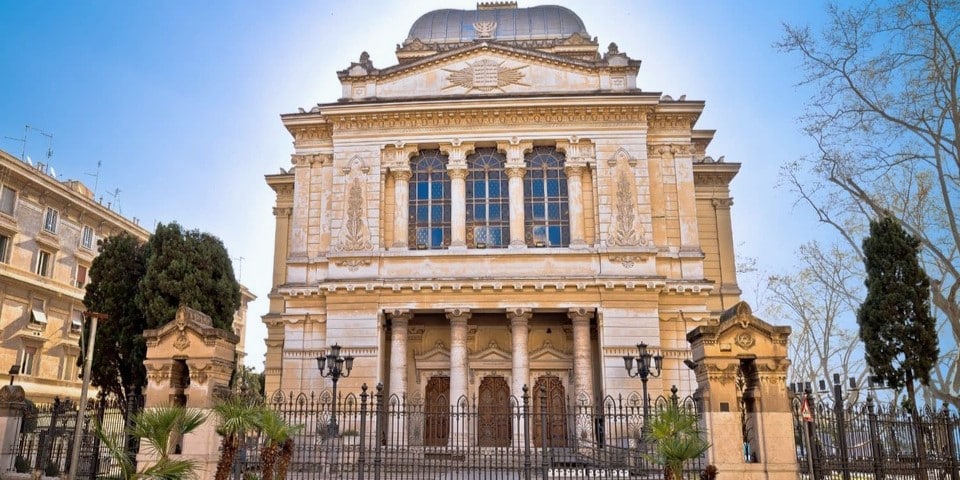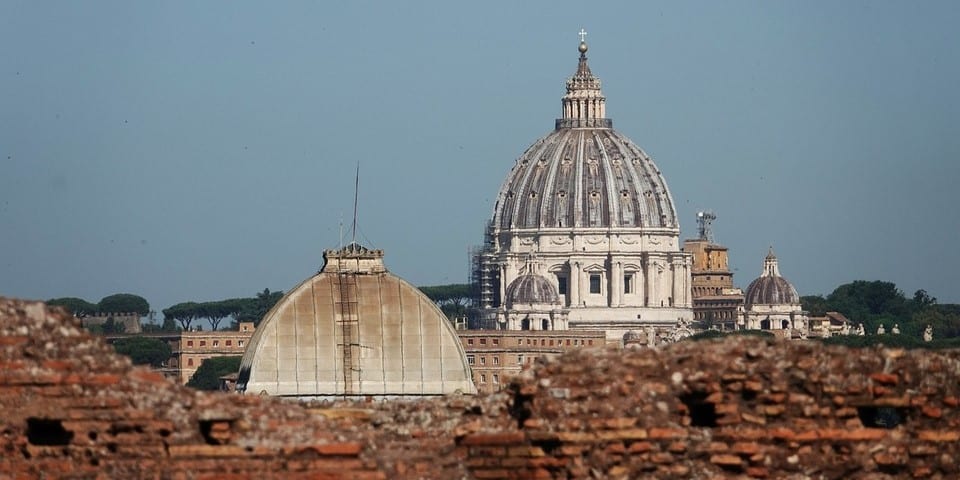

989440 travellers read

| Tip | The Synagogue can only be accessed through the Jewish Museum and must be visited as part of a guided tour offered by the museum. |
|---|---|
| Opening hours |
Sunday:
-
Monday:
-
Tuesday:
-
Wednesday:
-
Thursday:
-
Friday:
-
|
| Recommended tour | |
| Closest bus stops |
|
| Closest subway stations |
|
| Address | Lungotevere de' Cenci, Roma |
| Website | romaebraica.it |
The Great Synagogue (Italian: Tempio Maggiore di Roma) is a place for prayer and a symbol of the freedom of the Jewish community in Rome. It also serves as a cultural centre for the community. The Jewish Museum of Rome inside showcases the history of the Jewish community in the Eternal City.

Contents
ToggleOsvaldo Armanni and Vincenzo Costa designed the Great Synagogue. Construction took place between 1901 and 1904. Notably, they chose a striking Art Deco style to commemorate the newly gained independence of Rome’s Jewish community.
The Italian king Victor Emmanuel II granted Rome’s Jews full citizenship during his reign. As a result, the community began preparing for a new place of worship following the historic destruction of the old synagogue.
Judaism is a religion, the first to embrace monotheism, i.e. the belief in one G‑d.
According to tradition, Judaism developed among the Semitic tribes with Abraham, in a region that can historically be placed between Chaldea and Canaan around the 16th century BCE. It was Moses in the 13th–12th century BCE who gave the Jews their self-awareness as a people, leading them into the Land of Israel and transmitting the Divine Law: the Ten Commandments written on the Tablets of the Law, and the Torah or “Pentateuch”, i.e. the first books of the Bible. The 613 mitzvot (commandments) that Jews are obliged to observe are drawn from the Bible.
The diaspora began after the Roman conquest, and the Jews were dispersed throughout Spain and along the Mediterranean coasts (Sephardic Jews), in Central and Northern Europe (Ashkenazi Jews), and in Italy, where Jewish colonies already existed.
Alongside the Orthodox tradition (the main point of reference for Italian and Roman Jewry, even if not every individual strictly observes every commandment), modern Judaism comprises other movements. Especially in English-speaking countries, these movements aim to modernise some external aspects of Judaism (Conservative Judaism) or otherwise do not consider themselves strictly bound by tradition (Reform or Liberal Judaism).
Today, there are around 15 million Jews worldwide, 35,000 Jews in Italy, and 13,500 Jews living in Rome.
The Jewish Museum of Rome contains splendid works donated by Jews living in the Ghetto (1555–1870) to their five synagogues or “cinque scole”. The synagogues were not only places for prayer, but also centres for congregation and study. They served as the comfortable communal living rooms that were absent from the small, dark, damp houses of the Ghetto, and Roman Jews demonstrated their attachment to these shared spaces through sumptuous gifts.
Initially, Jews were traditionally moneylenders; their banks held precious or antique objects as collateral for the loans they provided. When these pledges were not redeemed, they were sold to recover the funds. As a result, one of the banks’ complementary trades was dealing in antiques. These two activities continued side by side until 1682, when Jewish loan banks were abolished to favour Christian banks, known as Monti di Pietà. While Jews were prohibited from working as bankers, trading in luxury items remained a permitted occupation.
As early as the 16th century, Jews were active in buying and selling furniture, textiles, and antiques. They also provided complete, ready-to-use interior furnishings for the palaces of the nobility, for temporary city residents, or for special occasions such as conclaves, periods of mourning, ceremonies, celebrations, performances, and festivals.
During the Ghetto period, Jews in Rome were not permitted to work as silversmiths, so they had to commission non-Jewish artisans when donating silver to their synagogues. All the silver objects produced in Rome and displayed in the Jewish Museum of Rome are the work of Christian silversmiths.
The textiles are primarily antique fabrics acquired second-hand from the palaces of the nobility. These were then adapted for synagogue use with embroidery and trimmings. Needlework was a speciality of the Roman Ghetto, with one unique aspect: in a world where it was a male profession, in the Ghetto, the embroiderers were women.
Shortly after Italy’s unification in 1870, when the Kingdom of Italy captured Rome and the Papal States ceased to exist, the current synagogue was constructed. Jews were granted citizenship, and the Roman Ghetto was dismantled. The complex building that had housed five scolas—the Italian-Jewish term for synagogues—within a single structure serving the Ghetto community was demolished, and the Jewish community began planning a new, impressive place of worship.
Commemorative plaques have been installed to honour the local Jewish victims of Nazi Germany and of an attack by the Abu Nidal Organisation in 1982.
The community chose this striking architectural style to ensure the structure would be a visible celebration of their freedom, clearly seen from many points across the city. As a result, the building is instantly recognisable, even from a distance, thanks to its aluminium dome—the only square dome in Rome. The interior of the Synagogue is richly adorned with Art Nouveau design elements.
It is highly recommended to dedicate at least an hour to the Museo Ebraico di Roma when visiting the Great Synagogue of Rome. The museum’s beautifully curated collection takes visitors on a journey through the history of the Jewish community in Italy, from their arrival in Ostia in the 2nd century BC to the present day.
The collection on display at the Jewish Museum is truly remarkable. The museum’s exhibits include historical decrees, liturgical objects, incunabula, and marble sculptures, all of which shed light on the rich social history of Rome’s Jewish community and their enduring efforts to preserve their identity in the face of papal restrictions.
Author: Kate Zusmann
This website uses cookies. For more info read the cookies policy
RomeItaly.guide © 2025. Created with love by Roman experts and guides.